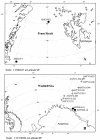Diversity and structure of bacterial communities in Arctic versus Antarctic pack ice
- PMID: 14602620
- PMCID: PMC262250
- DOI: 10.1128/AEM.69.11.6610-6619.2003
Diversity and structure of bacterial communities in Arctic versus Antarctic pack ice
Abstract
A comprehensive assessment of bacterial diversity and community composition in arctic and antarctic pack ice was conducted through cultivation and cultivation-independent molecular techniques. We sequenced 16S rRNA genes from 115 and 87 pure cultures of bacteria isolated from arctic and antarctic pack ice, respectively. Most of the 33 arctic phylotypes were >97% identical to previously described antarctic species or to our own antarctic isolates. At both poles, the alpha- and gamma-proteobacteria and the Cytophaga-Flavobacterium group were the dominant taxonomic bacterial groups identified by cultivation as well as by molecular methods. The analysis of 16S rRNA gene clone libraries from multiple arctic and antarctic pack ice samples revealed a high incidence of closely overlapping 16S rRNA gene clone and isolate sequences. Simultaneous analysis of environmental samples with fluorescence in situ hybridization (FISH) showed that approximately 95% of 4',6'-diamidino-2-phenylindole (DAPI)-stained cells hybridized with the general bacterial probe EUB338. More than 90% of those were further assignable. Approximately 50 and 36% were identified as gamma-proteobacteria in arctic and antarctic samples,respectively. Approximately 25% were identified as alpha-proteobacteria, and 25% were identified as belonging to the Cytophaga-Flavobacterium group. For the quantification of specific members of the sea ice community, new oligonucleotide probes were developed which target the genera Octadecabacter, Glaciecola, Psychrobacter, Marinobacter, Shewanella, and Polaribacter: High FISH detection rates of these groups as well as high viable counts corroborated the overlap of clone and isolate sequences. A terrestrial influence on the arctic pack ice community was suggested by the presence of limnic phylotypes.
Figures

References
-
- Amon, R. M. W., H.-P. Fitznar, and R. Benner. 2001. Linkages among the bioreactivity, chemical composition, and diagenetic state of marine dissolved organic matter. Limnol. Oceanogr. 46:287-297.
-
- Amon, R. M. W., and R. Benner. 2003. Combined neutral sugars as indicators of the diagenetic state of dissolved organic matter in the Arctic Ocean. Deep-Sea Res. Part I Oceanogr. Res. Pap. 50:151-169.
Publication types
MeSH terms
Substances
LinkOut - more resources
Full Text Sources
Molecular Biology Databases

